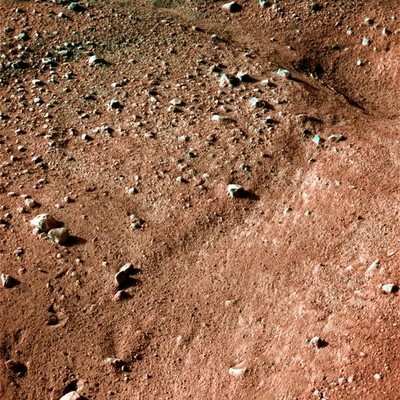May Explain Why Only Traces Of Ice Found
The Martian arctic soil that NASA's Phoenix Mars Lander dug into
this year is very cold and very dry. However, when long-term
climate cycles make the site warmer, the soil may get moist enough
to modify the chemistry, producing effects that persist through the
colder times.

Phoenix found clues increasing scientists' confidence in
predictive models about water vapor moving through the soil between
the atmosphere and subsurface water-ice. The models predict the
vapor flow can wet the soil when the tilt of Mars' axis, the
obliquity, is greater than it is now.
The robot worked on Mars for three months of prime mission, plus
two months of overtime, after landing on May 25. The Phoenix
science team will be analyzing data and running comparison
experiments for months to come. With some key questions still open,
team members at a meeting of the American Geophysical Union Tuesday
reported on their progress.
"We have snowfall from the clouds and frost at the surface, with
ice just a few inches below, and dry soil in between," said Phoenix
Principal Investigator Peter Smith of the University of Arizona,
Tucson. "During a warmer climate several million years ago, the ice
would have been deeper, but frost on the surface could have melted
and wet the soil."

With no large moon like Earth's to stabilize it, Mars goes
through known periodic cycles when its tilt becomes much greater
than Earth's. During those high-tilt periods, the sun rises higher
in the sky above the Martian poles than it does now, and the arctic
plain where Phoenix worked experiences warmer summers.
"The ice under the soil around Phoenix is not a sealed-off
deposit left from some ancient ocean," said Ray Arvidson of
Washington University in St. Louis, lead scientist for the lander's
robotic arm. "It is in equilibrium with the environment, and the
environment changes with the obliquity cycles on scales from
hundreds of thousands of years to a few million years. There have
probably been dozens of times in the past 10 million years when
thin films of water were active in the soil, and probably there
will be dozens more times in the next 10 million years."
Cloddy texture of soil scooped up by Phoenix is one clue to
effects of water. The mission's microscopic examination of the soil
shows individual particles characteristic of windblown dust and
sand, but clods of the soil hold together more cohesively than
expected for unaltered dust and sand. Arvidson said, "It's not
strongly cemented. It would break up in your hand, but the
cloddiness tells us that something is taking the windblown material
and mildly cementing it."

That cementing effect could result from water molecules adhering
to the surfaces of soil particles. Or it could be from water
mobilizing and redepositing salts that Phoenix identified in the
soil, such as magnesium perchlorate and calcium
carbonate.
The Thermal and Electrical Conductivity Probe on Phoenix
detected electrical-property changes consistent with accumulation
of water molecules on surfaces of soil grains during daily cycles
of water vapor moving through the soil, reported Aaron Zent of NASA
Ames Research Center, Moffett Field, CA, lead scientist for that
probe.

"There's exchange between the atmosphere and the subsurface
ice," Zent said. "A film of water molecules accumulates on the
surfaces of mineral particles. It's not enough right now to
transform the chemistry, but the measurements are providing
verification that these molecular films are occurring when you
would expect them to, and this gives us more confidence in
predicting the way they would behave in other parts of the
obliquity cycles."
 ANN's Daily Aero-Linx (04.16.24)
ANN's Daily Aero-Linx (04.16.24) Aero-News: Quote of the Day (04.16.24)
Aero-News: Quote of the Day (04.16.24) Airborne 04.10.24: SnF24!, A50 Heritage Reveal, HeliCycle!, Montaer MC-01
Airborne 04.10.24: SnF24!, A50 Heritage Reveal, HeliCycle!, Montaer MC-01 Airborne 04.12.24: SnF24!, G100UL Is Here, Holy Micro, Plane Tags
Airborne 04.12.24: SnF24!, G100UL Is Here, Holy Micro, Plane Tags Airborne-Flight Training 04.17.24: Feds Need Controllers, Spirit Delay, Redbird
Airborne-Flight Training 04.17.24: Feds Need Controllers, Spirit Delay, Redbird






